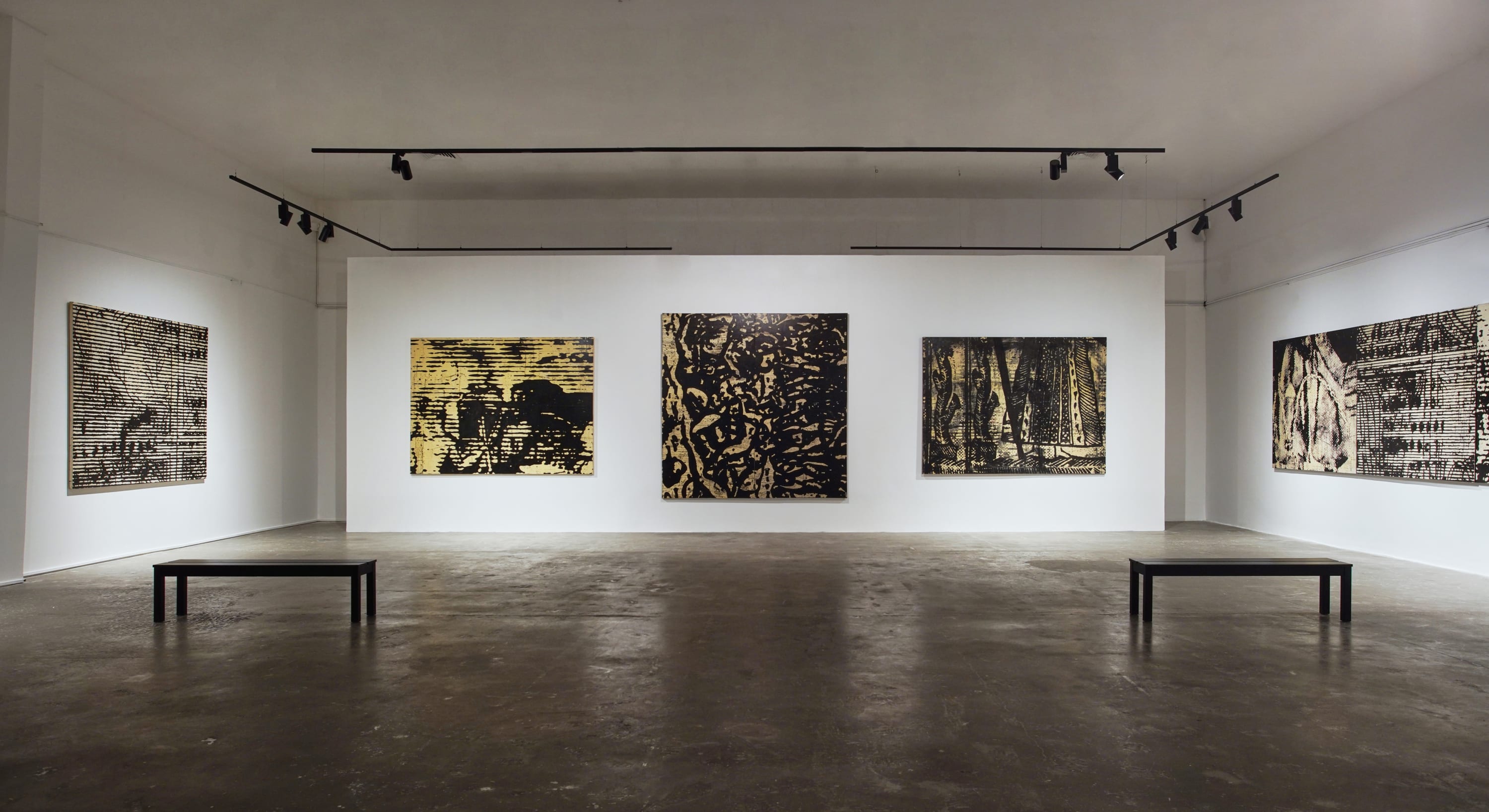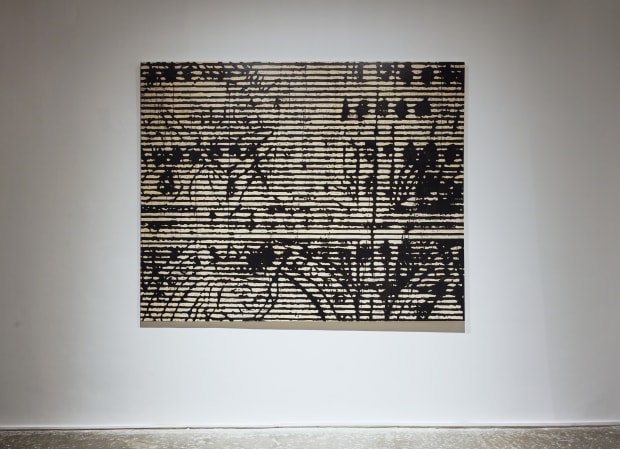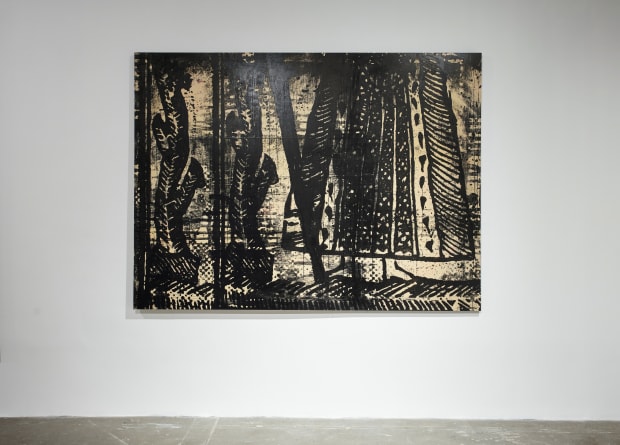-
Speaking truth to power has never been something Mahmoud Obaidi has shied away from in his work. The artist was introduced to the notion of injustice from his adolescence, and has since spent much of his life processing the destruction of his homeland and the isolation of exile. At the same time, he has found commonality in the suffering of a myriad of communities around the world who have also faced the brutal force of racism, occupation and inconceivable loss. In creating art which confronts these complex issues, Obaidi looks beyond simplistic politics and perceptions of identity, instead seeking to uncover and understand trauma from a historical, structural and geographical lens. As with much of Obaidi’s oeuvre, this latest body of work is made up of a multitude of layers which lie behind the external, visible yet abstract structures, shapes and colour, revealing a visual inquiry which goes far beyond the difficult topics which he seeks to tackle – namely colonisation and genocide – and simultaneously forces him to look within and explore his own personal sense of displacement.
-

-
During the 1980s, all of our generation was so surrounded by destruction that we could not help but make art. While many of my friends chose to write, I chose to paint
In March 2021, Obaidi spoke during an online event about his previous collection of work, ‘Compact Home’, stating to the panel and the international audience: “there is no place called home”. This perpetual sense of loss – loss of family, friends, identity, land and home – and the brutal physicality of being uprooted and thrown into unchartered, unstable territory has informed his very existence, seeping into his artistic output in a variety of ways. Born in 1966 in Iraq’s capital, Baghdad, Obaidi was influenced by his mother, a writer, who surrounded him with art and culture and encouraged him to develop his creative pursuits when he began to show artistic promise. He received a BA in fine art from the Academy of Fine Arts in Baghdad in 1990, the same year he had his very first solo exhibition, entitled ‘Cat’s Factory’, at the Museum of Modern Art (then called the Saddam Arts Centre). By that point, Iraq had already faced the impact of the Iran-Iraq War and it was beginning to feel the repercussions of the invasion of Kuwait, which resulted in the Gulf War and ensuing economic sanctions. The social environment that Obaidi was studying, graduating and exhibiting within, was a cocktail of heightened tensions and hyperpolitical rhetoric, and some of his earliest works showed signs of his natural inclination towards confronting political injustice. “During the 1980s, all of our generation was so surrounded by destruction that we could not help but make art. While many of my friends chose to write, I chose to paint”, Obaidi remembers.
-
-
The sanctions imposed upon Iraq severely limited the availability of art materials, and the state’s tight control over media and communications also limited exposure to the outside world, creating a suffocating environment for any artist. Obaidi left Iraq in 1991 via Jordan, Egypt, Tunisia, Thailand and China, seeking stability and peace. Instead, he felt stateless and stripped of a home, forced into exile from his homeland, which he could see crumbling from a distance. He eventually settled in Canada, where he found that stability he craved, continued his education and was able to resume his art practice. This relocation to North America not only provided him with a base to build a life on, but also opened his eyes to the historic and contemporary suffering and injustices of Indigenous communities in that region, feeling a sense of profound connection with their dispossession and longing. When Obaidi walked through an antique market in Venice one quiet Sunday afternoon, he came across a small papier-mache toy of a Native American man fighting a white man, clearly suggesting a classic problematic narrative of ‘good’ vs ‘bad’ or ‘civilised’ vs ‘savage’. Obaidi remembered the cowboy films he watched growing up, full of heroic scenes of fighting their enemies, who were seen as primitive anti-heroes. He bought the toy, and immediately was inspired to investigate the realities of this narrative and the places where it all came to life, becoming an ongoing project by Obaidi to commemorate victims, hold perpetrators to account, and also reflect personally on the deep scars left on the landscape and the bodies and souls of the dispossessed.
-

-

-
-
All of these themes have appeared heavily in Obaidi’s earlier work, including ‘Compact Home’ (2005–15), a series of dafatir – a term for artist’s books – incorporating a range of objects, materials and memories encased within boxes designed to be carried (the portable, compact home itself). This was one of many artworks created by Obaidi to explore and commemorate a lifetime of instability and exile, while other works confronted a more direct manifestation of injustice in the form of racism and notions of ‘whiteness’ and assimilation, for example in ‘How Not to Look Like a Terrorist’ (2010) and the connected installation, ‘Fair Skies’ (2010). He also directly explored the impact of decades of war on Iraq in projects such as ‘Uranium Generation’ (2020) and his extensive work on the Abu Ghraib Prison. In his 2015 painting ‘Remains of a Ravaged City’, we can also see links to this latest body of work, with a destroyed, dark landscape obscured and interrupted with violent black lines imprisoning the viewer in the remnants of what was once a land, a community, and a home.
-

-

-

-







